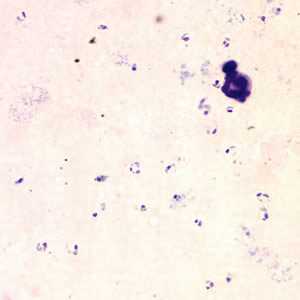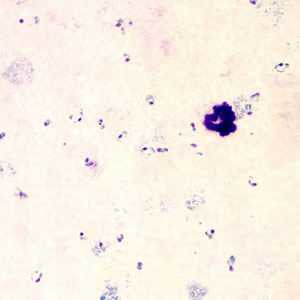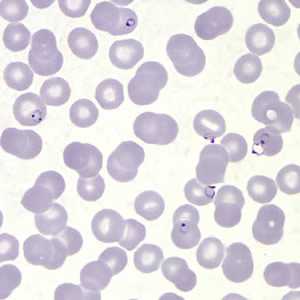
Case #153 - April, 2005
A 32-year-old male from Nigeria had been visiting some relatives in the United States for approximately a week. He went to a local emergency room for headaches, nausea, and general weakness and fatigue. Blood was drawn by fingerstick and thick and thin blood films were made. Images from the thick smears were captured and sent to CDC for confirmation. Figures A and B show what was seen on the Giemsa stained thick film when it was examined. What is your diagnosis? Based on what criteria? What additional steps would you recommend to achieve a definitive diagnosis?

Figure A

Figure B
Case Answer
This was a case of malaria caused by Plasmodium falciparum. Diagnostic features seen in images from the thick film were:
- a high number of thin, delicate ring forms (red chromatin dot and blue cytoplasm). No other stages were seen except rings, and this is often indicative of P. falciparum.
- traces of yellowish-brown pigment observed on just a few late rings/early trophozoite stages. This ruled-out the possibility of babesiosis.
While it is important to have a stained thin blood film to make a final diagnosis, an identification of P. falciparum can sometimes be made in some cases from a stained thick blood film. Examining the thick film first is useful for screening and for detecting possible mixed infections. Typical morphologic features of P. falciparum such as thin delicate rings, double chromatin dots, multiply infected cells, appliqué forms, and normal sized red blood cells are shown in the Figure C below (from the thin smear of the same case).

Figure A
More on: Malaria
Images presented in the monthly case studies are from specimens submitted for diagnosis or archiving. On rare occasions, clinical histories given may be partly fictitious.
DPDx is an education resource designed for health professionals and laboratory scientists. For an overview including prevention and control visit www.cdc.gov/parasites/.
- Page last reviewed: August 24, 2016
- Page last updated: August 24, 2016
- Content source:
- Global Health – Division of Parasitic Diseases and Malaria
- Notice: Linking to a non-federal site does not constitute an endorsement by HHS, CDC or any of its employees of the sponsors or the information and products presented on the site.
- Maintained By:


 ShareCompartir
ShareCompartir